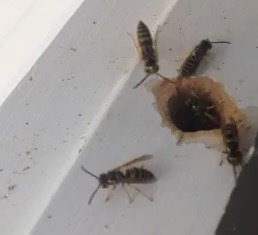This time of the year I get calls from home owners who are seeing an infestation of Paper Wasp’s inside of their homes. Several days ago I received a call from a worried mother. She has a two year old who sleeps in a second floor bedroom, and on several occasions she had found live paper wasp crawling on the heater in her son’s room in the morning. This of course is a scary thought for many, especially those with small children. Though the wasp would most likely cause no harm to a person, no one is comfortable seeing one in their home and around their children.
Wasps often winter in old tree trunks, under leaf and wood piles, and other warm, seemingly inconspicuous places. However, the development of homes and other man made structures has provided a new location for wasps to establish a nest that they consider to be safe and warm. Most of the wasp colony will die when the weather grows colder, but one or two of the females will produce an antifreeze that protects them and work their way farther in to an attic to hibernate. After a month or so the heat from a room below will revive these wasps just enough to draw them from the attics and further into your home. Once this has occurred it becomes more difficult to find the wasps, and although they will die inside they are still a frustrating pest to find inside of your home. You can solve this frustrating problem by treating the attic before the season begins, any wasps that try to move into your attic will die as a result and prevent any pest problems during the winter. Don’t wait to solve this problem and protect your house from wasps.
Paper Wasps
Description:
Family: Vespidae, Vespid Wasps
Description 1/2-1″ (13-25 mm). Slender, hornetlike. Short 1-segmented “waist” (pedicel) between thorax and abdomen. Upper portion of head pointed, never notched, as in hornets and yellow jackets. Head and body mostly reddish brown to black with yellow rings and reddish areas on abdomen. Male’s face pale, with antennae tips hooked; female has brown face. Wings amber to reddish brown.
Warning these wasps will sting if provoked or if their nest is disturbed, but they are usually not aggressive.
Food Adult drinks nectar and juices from crushed and rotting fruits. Larva feeds on insects pre-chewed by adults.
Life Cycle In spring several females work together to construct uncovered paper like, hanging nest of wood pulp and saliva. One female becomes dominant queen. 1st few generations in summer are all females, cared for as larvae by unmated female workers. Unfertilized eggs produce fertile males. Only mated young queens overwinter under leaf litter and in stone walls. Old queens, workers, and larvae die.
Habitat Meadows, fields, and gardens on flowers, and near buildings.
Range throughout North America.
Discussion Paper Wasps are much more tolerant of people and minor disturbances than are hornets and yellow jackets.
Give us a call today at 770-479-1598 and ask for a FREE 58 Point Pest Analysis of your home or office.
I hope to hear from you soon!

